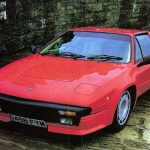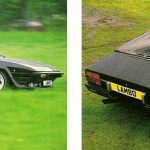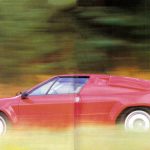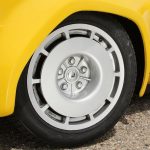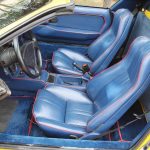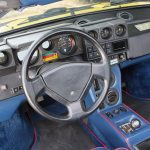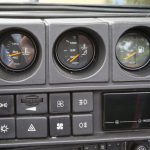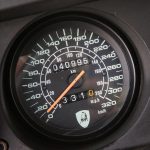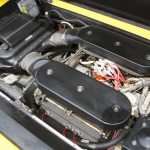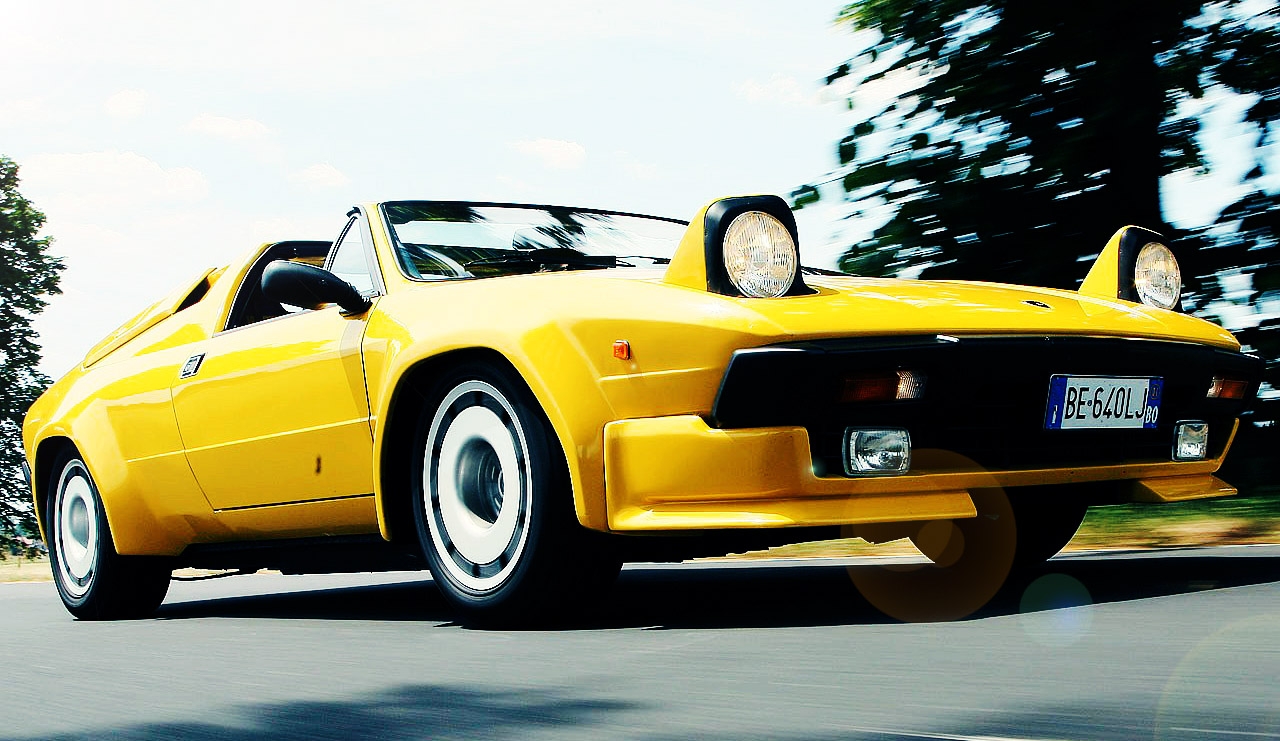
Taking the bull by the horns. Although its roots can be traced back through more than a decade’s development, the modern-day Lamborghini Jalpa 3500 represents a real alternative to the Porsche 911. We tested this exclusive Italian supercar.
ROAD TEST 1986 LAMBORGHINI JALPA 3500
PRICE £38,945.
TOP SPEED 144mph,
0-60mph 6.2secs,
MPG 15.9
FOR Performance, Brakes.
AGAINST Refinement, Gearchange
Security guards, it is probably safe to say, are not usually noted for having a sense of humour. There must be something about the 1986 Lamborghini Jalpa, then, for as we rolled up to the proving ground’s security building in a blood-red example of the Italian manufacturer’s ‘baby’ supercar, the visage of this particularly stony-faced individual actually creased into a smile.
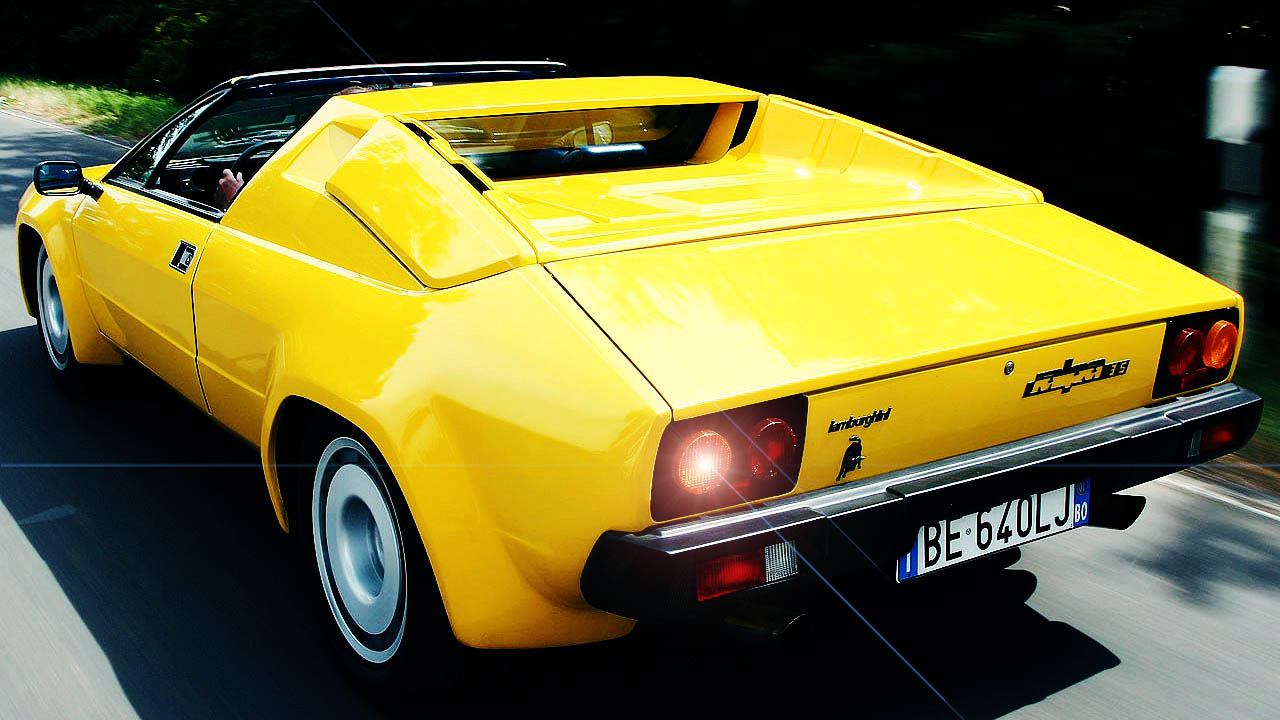
The questions same in rapid fire. “What is it?’ ‘A Lamborghini Jalpa.’ ’Italian… thought it might be. I low fast is it?’ ‘Well, the manufacturer claims about 154mph, but that’s partly what we’re here to find out.’ Clearly not a man to be impressed with such illegal speeds, the lines on his face were rapidly resuming their normal set. ’How much is it then?’ ‘On-the-road. it’s £39,545, but then this one is fitted with a sports exhaust which adds about another £550 to the price… “Humph” he snorted, before there had even been the opportunity to tell him about the optional rear wing costing £1150, “what fool would pay that sort of money for a car?”
Having found out what he wished to know about this strange device which had burbled up to his doorstep, he turned his back on us and returned to the security building where the steam from a boiling kettle, had fogged up the window. The temptation at that point to wind the sweet little Lamborghini V8 up to 6000rpm and drop the clutch was great, the noise and twin snaking black lines which would undoubtedly result perhaps serving as some sort of remainder to an automotive Philistine that not all motoring has to be of the underpowered, three-box variety.
We snicked the gear lever down into the dogleg first position, let out the heavy clutch and trundled into the proving grounds, while contenting ourselves with the thought that shortly we would be able to sample the performance and handling of this Italian exotic to the full.
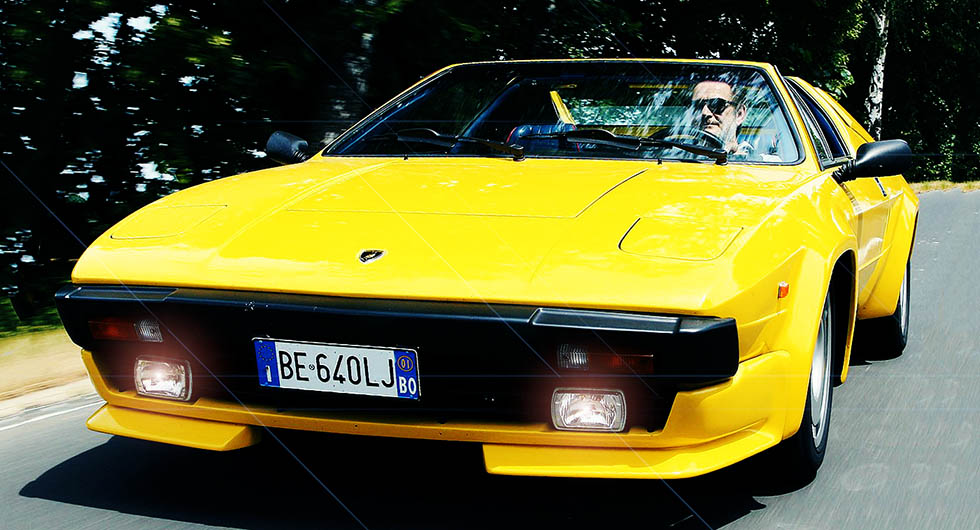
What a shame, though, that we had not been able to enlighten this man, to explain to him how the Jalpa had developed mechanically from the Urraco and visually from the Silhouette. Furthermore, we could have explained that the method of construction used for the Jalpa — pressed steel panels welded to form a unitary structure — was completely different from that used for the car’s big brother, the
Lamborghini Countach with its square tube spaceframe and hand-beaten aluminium skin. And then we could have got into the differences in power units between the two cars — a transversely mounted 3.5-litre V8 for the Lamborghini Jalpa as opposed to a longitudinally mounted. 4.8-litre V12 for the Countach. And then there’s the suspension… somehow, though, that would probably have been a bit like trying to explain the finer points of French cuisine to an Amazon Indian.
PERFORMANCE
Even a brief drive in the Jalpa reveals that the V8-engine is quite different in nature from that fitted to the recently tested De Tomaso Pantera. The latter is powered by a 5.8-litre Ford ‘Cleveland’ V8 producing, in the form tested, well over 300bhp. It is not. by any strength of the imagination, a subtle power unit. If Popeye on spinach were a car, he’d be a De Tomaso Pantera.
| ACCELERATION FROM REST | |||
| mph | sec | kph | sec |
| 0-30 | 2.2 | 0-40 | 1.9 |
| 0-40 | 3.2 | 0-60 | 2.8 |
| 0-50 | 4.9 | 0-80 | 4.3 |
| 0-60 | 6.2 | 0-100 | 6.5 |
| 0-70 | 8.1 | 0-120 | 8.9 |
| 0-80 | 10.0 | 0-140 | 11.6 |
| 0-90 | 12.4 | 0-160 | 14.7 |
| 0-100 | 15.6 | 0-180 | 18.7 |
| 0-110 | 19.1 | 0-200 | 29.9 |
| 0-120 | 23.3 | Standing 1 km | 26.8 / 124 mph terminal speed |
|
0-130 |
30.8 | ||
|
0-140 |
39.5 | ||
|
0-150 |
– | ||
| Standing ¼ mile | 14.7 / 96 mph terminal speed | ||
| ACCELERATION IN TOP (5TH) | |||
| mph | sec | kph | sec |
| 20-40 | 7.4 | 40-60 | 4.7 |
| 30-50 | 7.0 | 60-80 | 4.3 |
| 40-60 | 7.8 | 80-100 | 4.3 |
| 50-70 | 7.0 | 100-120 | 4.4 |
| 60-80 | 7.1 | 120-140 | 4.5 |
| 70-90 | 7.2 | 140-160 | 5.0 |
| 80-100 | 7.9 | 160-180 | 5.4 |
| ACCELERATION IN 4TH | |||
| mph | sec | kph | sec |
| 20-40 | 5.1 | 40-60 | 3.2 |
| 30-50 | 4.8 | 60-80 | 2.9 |
| 40-60 | 4.7 | 80-100 | 2.8 |
| 50-70 | 4.6 | 100-120 | 2.9 |
| 60-80 | 4.6 | 120-140 | 3.0 |
| 70-90 | 4.6 | 140-160 | 4.3 |
| 80-100 | 4.9 | 160-180 | 6.0 |
| 90-110 | 5.8 | 180-200 | 6.5 |
| 100-120 | 6.9 | ||
The 3.5-litre Lamborghini V8, however, with its all-alloy construction, twin overhead cams and four twin-choke Weber carburettors is perhaps slightly effeminate by comparison, but nonetheless mighty impressive. It may not have the low-down “grunt” of a big displacement V8, but it more than makes up for any deficiency in this area with its gloriously free-revving nature. There aren’t too many V8s, outside of those installed in out-and-out racing cars, that will sing happily right round to a 7500rpm redline. This one does.
The gear ratios have been chosen accordingly, being quite tightly spaced, and it is necessary to make liberal use of the throttle pedal and sturdy, no-nonsense gear lever if good progress is to be made. Keep the engine on song and it howls rather like a Rover V8.
| SPEEDOMETER (mph) | |||||||||
| Speedo mph | True mph | ||||||||
| 32 | 30 | ||||||||
| 42 | 40 | ||||||||
| 52 | 50 | ||||||||
| 63 | 60 | ||||||||
| 74 | 70 | ||||||||
| 86 | 80 | ||||||||
| 96 | 90 | ||||||||
| 106 | 100 | ||||||||
| 116 | 110 | ||||||||
| 128 | 120 | ||||||||
| 138 | 130 | ||||||||
| 149 | 140 | ||||||||
Doing just that, we netted in-gear maxima of 48, 64 (allowing one to sneak in the all-important 0-60mph increment without a second gear change), 91 and 114mph in the lower four ratios using the previously mentioned 7500rpm redline. It certainly feels as though the engine would happily continue revving above this level, but we chose to stick to our self-imposed limit for the purpose of this test.
For a relatively small displacement V8, the Lamborghini unit also turned out to be remarkably tractable, pulling from 10mph in all but top gear without the slightest trace of baulkiness. The consistency of the 20mph increments in the mid-range is good evidence of the excellent responsiveness; if you want to overtake there’s instant and usable power available throughout the rev range. As can be seen, the quickest 30-50mph increment is 2.5secs in second gear while 50-70mph takes only 3.8sces in third gear.
| FUEL CONSUMPTION | ||
| Overall | 15.9 mpg 17.8 litres/100 km | |
| Touring* | 20.5 mpg 13.5 litres/100 km | |
| Govt tests | 14.8 mpg (urban) 27.4 mpg (56 mph) 23.2 mpg (75 mph) | |
| Hard | 14.3 mpg | |
| Average | 17.5 mpg | |
| Gentle | 20.7 mpg | |
| Fuel grade | RM97 octane Premium | |
| 4 star rating | ||
| Tank capacity | 80 litres | |
| 17.6 Imp galls | ||
| Max range* | 317 miles | |
| 530 km | ||
| Test distance | 630 miles / 1014 km | |
| Based on official fuel economy figures – 50 per cent of urban cycle, plus 25 per cent of each of 56/75 mph consumptions. | ||
| STEERING | ||
| Turning circle / Lock to lock | 9.4 m 30.7 ft / 4.2 turns | |
| NOISE | dBA | |
| 30 mph | 72 | |
| 50 mph | 75 | |
| 70 mph | 83 | |
| Maximum level | 94 | |
| Peak noise level under full-throttle acceleration in 2nd | ||
| Distance recorder: 2.6 per cent slow | ||
| WEIGHT | kg | cwt |
| Unladen weight* | 1407kg / 3109lb | 27.7 |
| Weight as tested | 1585kg / 3504lb | 31.3 |
| Max payload | 225kg / 497lb | |
| Weight distribution F/R | 43.2 % / 56.8 % | |
If there is slight disappointment to be expressed over what are, after all, some pretty impressive performance figures, it would concern the 144mph mean maximum speed and the 0-60mph time of 6.2secs.
We carried out our top speed runs around the Millbrook proving ground two-mile, high-speed bowl and. even allowing for a potential speed loss due to tyre scrub on the banking, we could get nowhere near the claim for the car of 154mph. As can be seen from the data section, the engine was turning over at 7000rpm at the mean maximum; we would have had to find another 500rpm in fifth gear if we were to achieve the manufacturer’s claim. On the day, it simply wasn’t there.
Traction off the line, as attested to by the 2.2secs time to 30mph. is prodigious. The problem is the gearchange. On a quick run, you have to fight the lever out from the dog-leg first, on the lower left of the metal shift pattern plate in which the gear lever runs, into second gear and the change simply doesn’t like to be hurried. Without a doubt, the more brutal you are with the gearchange, the quicker it is. It would seem feasible that a driver well used to the idiosyncrasies of the Jalpa’s gearbox could record a sub-6secs 0-60mph time, for whatever that might be worth to the traffic-light burn-out brigade.
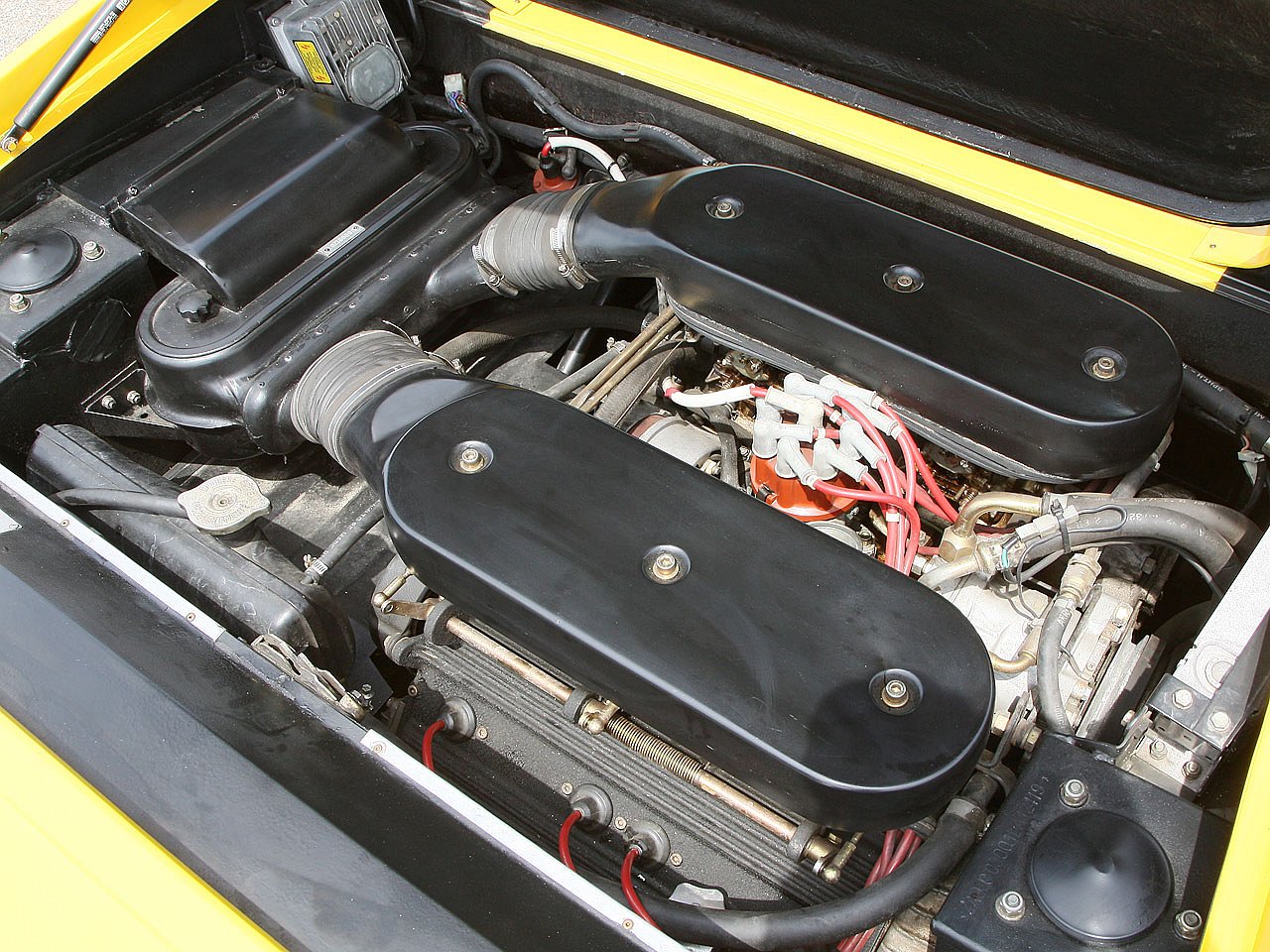
Opposite page: first signs of Jalpa came with the aggressive looking Silhouette. This page: Jalpa’s 3.5 V8 produces 255bhp
The outright performance element aside, arguably the most impressive aspect of the Jalpa’s engine is its total lack of temperament. It starts with case using either the long-standing Weber technique of three deep pumps on the accelerator pedal or by using the choke control lever mounted on the centre console near the handbrake. Once the eight cylinders have burst into life, the power unit settles down to an even idle and pulls without any sign of hesitation. Perhaps more importantly for urban- dwelling owners of the Jalpa, the engine withstands the rigours of slow-moving traffic without any signs of overheating or oiling up.
| MAXIMUM SPEEDS AT TEST | |||
| Gear | mph | kph | rpm |
| OD Top (mean) | 144.0 | 232.0 | 7.000 |
| (best) | 145.0 | 233.0 | 7.050 |
| 4th | 114.0 | 184.1 | 7.500 |
| 3rd | 91.0 | 146.1 | 7.500 |
| 2nd | 64.0 | 103.2 | 7.500 |
| 1st | 48.0 | 77.0 | 7.500 |
ECONOMY
Quite rightly, one wouldn’t expect a car with 150mph potential performance to be particularly frugal with petrol. In absolute terms, the Jalpa’s overall consumption of 15.9mpg confirms a fair thirst for fuel, but compare it with other cars offering the same sort of performance, and it doesn’t look at all bad.
In fact, in the course of over 1000 miles of motoring, consumption figures ranged from a worst of 13.9mpg — as usual, after testing — to a best of 18.2mpg. It is difficult to restrain the right foot when it has command over such a powerful, willing engine but a little self-control should sec the 17.6-gallon fuel tank provide the Jalpa with a range of about 300 miles. In fact, the Lamborghini’s consumption is all the more admirable when one takes into consideration its weight — at 3109lb it is by no means a lightweight, which partially confirms the suspicion that the Jalpa may be just a little over-engineered.
The fuel filler lives behind a hinged, locking flap high on the offside rear panel. As sometimes happens with free-revving engines, the V8did prove to have something of a thirst for oil, it proving necessary to add a litre of Mobil 1 synthetic oil in the course of just over 1000 miles.
REFINEMENT
On the noise front, the situation is dominated by that engine. Mind you, it’s unlikely that anyone buying an Italian exotic car would be averse to mechanical noise, particularly when it takes the form of the glorious howl which emanates from the four exhausts of the Lamborghini’s V8. There is also a considerable amount of gear whine in the intermediates which is particularly difficult to achieve bearing in mind the nature of the power unit.
There is also some tyre rumble from the wide Pirelli P7s. depending on the coarseness of the surface being traversed, but road noise, along with wind noise, is generally well controlled at all UK-legal speeds. Having said that, potholes and other similar imperfections can elicit a really crashy reaction from the firm suspension which at times seems to reverberate through the whole body shell.
With the engine turning over at about 3400rpm on part throttle and road and wind noise held to a reasonable level at the 70mph limit, the Jalpa is not an overly tiring long distance cruiser. Pick the speed up above this level though, and the picture changes quite noticeably. Engine noise is directly proportional to the amount of throttle being applied, but road and particularly wind noise increase markedly. The ride seems to smooth out the faster the car goes with far fewer clonks bumps being transmitted to the occupants, while the wind roar emanates primarily from the removable roof panel and the unusually shaped door mirrors which also vibrate quite noticeably at speed. To put it in context, at 100mph it isn’t necessary to wear earplugs in the Lamborghini but you do have to raise your voice to be heard. Or put another way, a Sierra RS Cosworth would be a whole lot quieter at the same speed.
Wheel removed, space is tiny.
ROAD BEHAVIOUR
The combination of wide section (205 front, 225 rear), low profile tyres, closely controlled suspension and the sort of low centre of gravity associated with a vehicle which measures up to the door handles of most normal cars, is suggestive of a ride-handling compromise biased strongly in favour of the latter. And so it turned out to be.
In most normal driving circumstances, the combination of grip and traction afforded by the mid-engined configuration plus that instantly responsive power unit means the Jalpa is a most satisfying device to hustle over twisting country roads. Natural handling balance in such circumstances is understeer, even lifting off the power in mid-corner failing to have any sort of destabilising effect — the understeer which is building up simply neutralises.
The reassuring handling is aided by the non assisted rack and pinion steering. At 4.2 turns from lock to lock, it really is a bit low geared, a point which the driver notices particularly around town, but at high speeds, it is quite magnificent, providing reassuring weighting with just the right amount of feedback. It is generally an attribute of mid-engined layouts that the front wheels are not too heavily laden and power-assistance for the steering is therefore not a necessity.
Mention of weight distribution brings to mind a warning which should be sounded about the Jalpa’s handling: although, as mentioned, in virtually all normal roadgoing situations it is exemplary, it is also necessary to be cautious when pressing on in wet conditions. For a mid-engined car, the Lamborghini has rather more of a rearward weight bias (43.2/56.8) than one might expect, with the result that the back end of the car can step out of line quite smartly. As we discovered at the test track, ultimate handling is rather like a Porsche 911 in that if the back end is provoked out of line beyond a certain point by unsettling the car and then applying power in fairly brutal fashion, it is virtually impossible to counter the rapidly developing spin.
Ride quality is perhaps best de-scribed as firm and rather unforgiving at town speeds. In fact, it is a bit of a filling-rattier over poorly surfaced roads, a situation which is not aided by the minimal ground clearance of the Jalpa; you’ve got to be very careful of that front spoiler when pulling into inclined drives. Like the steering, though, the ride comes into its own at higher speeds when it smooths out nicely. Strong side winds can be felt at these speeds, but general stability is in line with the car’s performance potential.
The same could also be said of the four-wheel ventilated discs (10.9ins diameter) with their servo assistance. They pull the Lamborghini down from speed without the slightest drama and shook off the Autocar fade test with case. Brake response is equally impressive. We recorded 1.05g with 100lb of pedal pressure but the brakes would not display the slightest sign of locking until we had applied a massive 160lb to the pedal.
AT THE WHEEL
The surroundings in which the Lamborghini Jalpa driver finds himself once he climbs behind the unusual, fully leather-wrapped steering wheel are obviously rather different from those of your average mass-produced hatchback.
For one thing, there’s the driving position: low-slung and semi-reclining with an unusually high-mounted steering wheel — definitely not to everyone’s taste, although this layout docs allow good legroom for taller drivers. The ideal situation would be to provide both seat height and steering column adjustment so the driving position could be more closely tailored to an individual’s shape and size. The seats themselves are quite narrow and turned out to be not overly comfortable on longer journeys.
At the risk of offending feminists everywhere, the Jalpa gives the impression of being a very masculine car. The gearchange, as mentioned, requires a lot of physical effort and yet the harder you use it, the easier the changes become. Adding to the impression are the 50lb clutch, heavy, long-throw accelerator pedal and low-geared steering. In that respect, the Jalpa is very much a car which needs to be picked up by the scruff of the neck and driven hard if you are to get the best from it.
One area which is often weak in mid-engined sports cars is visibility, particularly to the rear three-quarter. Clearly, the low slung seating affects forward vision to an extent, but visibility is quite reasonable, particularly to the from and sides. The back window is small (and happily, not prone to misting up) but does provide some sort of view to the rear. Lane change manoeuvres or exits from sharply angled junctions require the most care and it is here that the remote-control door mirrors are absolutely essential. The only slight drawback is that they vibrate badly at speed (the interior mirror is only marginally better).
CONVENIENCE
With a certain amount of flipness, one could dismiss this section with the comment “not very much”. Few potential customers for cars such as the Jalpa, however, are likely to be deeply concerned with practicality.
In actual fact, as mid-engined sportscars go, this Lamborghini is not bad. There is actually something approaching a boot behind the engine compartment which looks as though it would hold cither a golf bag and trolley or certainly several soft-sided bags. There is also a limited amount of space behind the seats, although this is intended to take the targa roof panel.
Removal of the roof section, incidentally, is supposed to be a one-person job, but it turns out to be much easier if you have some assistance. Similarly, refitting it can be a fiddly operation, primarily because the rear latches have to be carefully aligned before the trailing edge of the roof can be pulled down into position.
The tiny front compartment contains a BMX-size alloy wheel and space-saver tyre plus various reservoirs and the heat exchanger for the air conditioning equipment. It is not, however, even vaguely usable as a storage area. One item on the Lamborghini which earned almost universal derision from testers was the glovebox. The leather-covered door is released by a small button on the lower right-hand corner, at the same time as it is pulled down at the top comer.
With the reserves of overtaking power, braking and handling that the Jalpa possesses, active safety is undoubtedly a strong point. In addition, the unitary body structure offers considerable strength in the event of an impact.
Visibility, as we have already discussed, is particularly important in such a low-slung car and we were particularly impressed with the de-misting arrangements in the Lamborghini. Rising engine heat obviously helps to keep the all-important rear window clear while the large wind screen is also quickly cleared by the heater. We found the controls over-complicated and the unit difficult to “fine-tune”, but there can be no denying the amount of warm air it throws out.
Two items in particular could be singled out for criticism in this area: the seat belts and the headlamps. The former have the diagonal sections mounted in such a way that they cut across occupants’ necks, while the buckle on the driver’s side often gets in the way when there is a lot of steering wheel twirling going on. The result is that the belt releases itself and the driver then has to try and refasten it on the move. As for the headlamps, they simply don’t seem quite up to the performance which is on tap from the Jalpa, particularly on dipped beam.
VERDICT
There are those who will argue that the Lamborghini Jalpa basks, to a degree, in reflected glory from the amazing Countach quattrovalvole but that is to do little brother a severe disservice. Given that no one is likely to buy a car in this class for sensible reasons, the Jalpa actually makes more sense than a number of its obvious competitors. Inexpensive it is not — it would diminish its appeal if it was — but it will actually convey two full-sized people and a limited amount of luggage (in soft-sided bags) in reasonable comfort.
The jewel in this particular crown, however, is the engine. There are many automotive aficionados who will admit to going weak at the knees if exposed to the sound of a Porsche flat six being used in anger while others prefer the scream of a high-revving four. But the crisp little V8 in the Lamborghini is an absolute jewel, revelling in hard use but also quite capable of pottering around in the lower gears in the heaviest town traffic.
The Jalpa may not have quite the fit and finish of, say, a Porsche 911, but it would seem to be virtually as practical a proposition. There is also a certain indefinable magic about any car carrying that raging bull insignia.
THE 1986 OPPOSITION
BMW M635CSi E24 £38,990

Not a true ‘supercar’ in the Italian sense of the word but in terms of performance and practicality it is a real contender in this segment of the market place. Powered by the ultimate in BMW 6-cylinder M88 24-valve technology, it is a comfortable and elegant coupe with good visibility. Excellent steering with more predictable rear-end road holding.
DE TOMASO PANTERA GT5-S £41,410

Last of the American-engined Italian ‘supercars’, with design dating back to 1970. Mid-mounted V8 Ford engine has capacity of 5.8 litres and is available in three stages of power from 270 to 300bhp. Safe, predictable hand-ling, but steering rather heavy at low speeds. Massive ventilated discs give huge stopping power. Seating limited to two only. De Tomaso Pantera
FERRARI 328 GTS £39,975

The prancing horse and that blood-red paint still hold a certain magic and anyone who has sat in front of the famous V8 lump will know what it is like to feel the hairs on the back of the neck standing up. Retains all the classic Ferrari foibles; heavy clutch and gear-change and poor driving position. But the 328 still turns heads wherever it goes. Ferrari 328 GTS
JAGUAR XJ-SC-V12 £28,300

The cabriolet version of the V12-powered Jaguar XJ-S is a sports tourer in the classic British tradition. Smooth power delivery, refinement and comfort equals satisfying performance with the obvious advantage of removable roof panels. There are faster cars in terms of outright performance but where the Jaguar scores highly is in value for money.
LOTUS ESPRIT TURBO £24,980

If one can have such a thing, the Lotus is the efficient sub-supercar, providing near-140mph performance from one of the few acceptable turbo engines; excellent response and wide spread of smooth power belies 2.2-litre origin. Low weight and drag of Giuglaro body helps relatively good fuel consumption. Superb handling: poor vision.
PORSCHE 911 TARGA SUPERSPORT (G-Model) £41,795

The flat-six, rear engine design of the Carrera has now become a classic. Performance, provided by the 231 bhp, 3.2-litre, air-cooled engine, is outstanding. Ultimate handling, especially in the wet, can be a test for the inexperienced driver. Ride quality good, and brakes wellabletohandlc the car’s speed. Targa-top gives the advantage of open-top motoring.
| Car | BMW M635CSi E24 | De Tomaso Pantera | Ferrai 328GTS |
Jaguar XJ-SC-V12 |
Lotus Esprit Turbo
|
Porsche 911 Targa Supersport (G-Model) |
| Model Year | 1984 | 1984 | 1985 | 1985 | 1985 | 1986 |
| Capacity, cc | 3453 | 5763 | 3185 | 5345 | 2174 | 3164 |
| Power, bhp/rpm | 286/6500 | 270/5600 | 267/7000 | 295/5500 | 210/6250 | 231/5900 |
| Torque, lb ft/rpm | 251/4500 | 325/4500 | 224/5500 | 320/3250 | 200/4500 | 210/4800 |
| Max speed, mph | 156 | 160 | 163 | 140 | 138 | 148 |
| 0-60 mph, sec | 6.1 | 5.4 | 6.4 | 7.7 | 6.1 | 5.6 |
| 30-50 mph in 4th, sec | 5.5 | 7.5 | 4.9 | 7.0 | 4.6 | 2.2 |
| mph/1000 rpm | 26.7 | 26.3 | 23.5 | 24.4 | 26.6 | 30.5 |
| Overall mpg | 12.1 | 11.3 | 11.6 | 11.1 | 15.9 | 17.1 |
| Touring mpg | 19 | 14 | N/A | 14 | 20.4 | 23.4 |
| Weight, lb | 3322 | 3292 | 1407 | 1422 | 1308 | 1540 |
| Drag coefficient Cd | 0.39 | 0.40 | N/A | 0.42 | 0.39 | 0.38 |
| Boot capacity m3 | 0.21 | 0.25 | Not measured | Not measured | 0.28 | 0.21 |
| Lenght | 176,6 | 181,3 | 167,5 | 163,0 | 169,0 | 175,0 |
| Width | 77,8 | 72,0 | 71,0 | 78,8 | 65,0 | 72,3 |
| Height | 44,5 | 52,0 | 43,3 | 42,0 | 52,0 | 51,8 |
| Wheelbase | 100,4 | 102,8 | 106,3 | 96,5 | 89,5 | 98,5 |
| Front track | 59,8 | 59,3 | 57,0 | 58,8 | 56,3 | 61,0 |
| Rear track | 65,4 | 59,0 | 57,5 | 63,3 | 59,0 | 60,3 |
| Weight disribution front/rear % | 45/55 | 53/47 | 41/59 | 38/62 | 35/65 | 53/47 |
Lift-off targa panel slows behind seats. Power unit is difficult to get at and maintenance strictly for professionals. Leather trimmed seats and door panels add a luxurious touch. Slimline spare wheel lives in the front compartment. Ventilation in the Jalpa is good by supercar standards. Carpet-lined boot is deep but narrow from back to front.

1 Fuel contents. 2. Oil temperature. 3. Engine coolant temp, 4. Trip 5. Speedometer. 6. Oil pressure, 7. Rev counter. 8. Air fan switch. 9. Ammeter. 10. Door mirror adjustment. 11. Windscreen wipers washers. 12. Indicators, lamp mam beam. 13. Heating and vernation. 14. Window switches. 15. Cigar lighter, 16. Stereo. 17. Air conditioning
TECHNICAL FOCUS
The Jalpa is unusual among so-called supercars. Although virtually all have the engine located behind the passenger compartment in either mid or rear-engined configuration, few have the power unit slung transversely in front of the rear wheels.
As with many engines, the V8 in the Jalpa does not have its origins in this present model, but rather traces it roots back to the original 2.5-litre power unit which propelled the unusually named Lamborghini Urraco, a model that appeared for the first time at the Turin Show in 1970. All the castings used in this small displacement V8 were of light alloy and the heads were cast in two parts, the lower section containing the valves and ports, and the top layer the camshaft. At this stage in the engine’s development, it was fitted with only one camshaft per cylinder bank, each driven — unusually for a high-performance engine — by a toothed belt.
On four downdraught Weber carburettors, this unit produced 220bhp at 7500rpm and 166lb ft of torque at a very high 5750rpm.
When the Lamborghini Urraco P300 appeared in 1974, the engine displacement had increased and the one-piece cylinder heads each sported two overhead cams. The changes meant power output had increased to 250bhp at 7500rpm and torque to 195lb ft at a far more reasonable 3500rpm.
The first signs of the present Jalpa came with the arrival of the Silhouette. This open-topped sports car was almost completely on the mechanicals of the Lamborghini Urraco P300, but featured a far more aggressive appearance. By dint of a still longer stroke, the engine had also turned into what was to become the Jalpa power unit.
The 3485cc, 90deg V8 with its 86 x 75mm bore and stroke is still fabricated with light alloy and features twin overhead cams and two valves per cylinder. On four Weber 42 DCNF carburettors and a compression ratio of 9.2-to-1, it produces 255bhp at 7000rpm and 231lb ft of torque at 3500rpm.
| Car | 1986 Lamborghini Jalpa 3500 |
| Made in | Italy |
| Car type | mid-engined, rear wheels drive 2-doors and 2-seats coupe |
| Number built | 1981 – 1988 / 410 produced |
| ENGINE | |
| Type | 8-cylinders, V8 |
| Head/block | All alloy |
| Cylinders | 8 / 90-deg |
| Main bearings | 5 |
| Cooling | Water |
| Fan | Viscous |
| Bore, mm (in.) | 86 (3.38in) |
| Stroke, mm (in.) | 75 (2.95in) |
| Capacity, cc (in.) | 3485 |
| Valve gear | OHC – 16-valve / 2-valves per cylinder |
| Camshaft drive | Belt |
| Compression ratio | 9.2-to-1 |
| Ignition | Electronic breakerless |
| Fuel injection | four twin-choke Weber 42 DCNF |
| Max power | 255 bhp / 190 KW (DIN / ISO) at 7.000 rpm |
| Max torque | 231lb ft / 315 Nm (DIN / ISO) at 3.500 rpm |
| TRANSMISSION | |
| Type | 5-speed manual |
| Clutch | Hydraulic, diaphragm spring 9.4in dia |
| Gear Ratio | mph/1000rpm |
| Top | 0.871-1/20.62 |
| 4th | 1.185-1/15.60 |
| 3rd | 1.478-1/12.50 |
| 2nd | 2.105-1/8.53 |
| 1st | 2.801-1/6.41 |
| Final drive gear Ratio | Hypoid bevel 4.0-to-1 |
| SUSPENSION | |
| Front location | Independent, MacPherson struts, lower wishbones, coil springs, telescopic dampers, anti roll bar |
| springs | oil |
| dampers | Telescopic |
| anti-roll bar | Yes |
| Rear location | Independent, MacPherson struts, lower wishbones, coil springs, telescopic dampers, anti roll bar |
| springs | oil |
| dampers | Telescopic |
| anti-roll bar | Yes |
| STEERING | |
| Type | Rack and pinion |
| Power assistance | No |
| Wheel diameter | 14.0 in. |
| Turns lock to lock | 4.2 |
| BRAKES | |
| Circuits | Twin, split front/ front and rear |
| Front | 278mm / 10.9 in. dia. ventilated disc |
| Rear | 278mm / 10.9 in. dia. ventilated disc |
| Servo | Vacuum |
| Handbrake | Centre lever, rear drum within disc |
| WHEELS | |
| Type | Light all alloy 16in Campagnolo |
| Rim Width | 8 x 16 in dia |
| Tyres make | Pirelli P7 |
| type | 7.5in rims |
| size | 205/55 VR16 and 225/50 VR16 |
| pressure | F33 psi, R36 psi / 2.3/2.4 bar |
| EQUIPMENT | |
| Battery | 12V 55 Ah |
| Alternator | 65Amp |
| Headlamps | 110/120W |
| Reversing lamp | Standard |
| Hazard warning | Standard |
| Electric fuses | 23 |
| Screen wipers | Two-speed plus intermittent |
| Screen washer | Electric |
| Interior heater | Water valve |
| Air conditioning | Extra |
| Interior trim | Leather or cloth seats, pvc head-lining |
| Floor covering | Carpet |
| Jack | Screw pillar |
| Jacking points | Two each side, under sills |
| Windscreen | Laminated, tinted |
| Underbody | Paint system. |
| protection | bitumastic. pvc |
Make: Lamborghini
Model: Jalpa
Modification 3500
Country of Origin: Italy
Maker: Nuova Automobili Ferruccio Lamborghini SpA, via Modena 12, 40019 Saint Agata Bolognese, Bologna, Italy.
UK Concessionaire:
Total Price 1986: £40.091.25 (1986 UK)
Options: Sport axhaust ssystem (£546.25)
Extras fitted to test car. None


